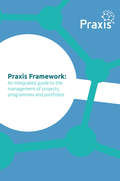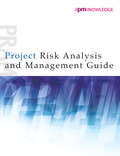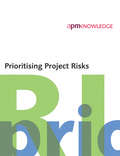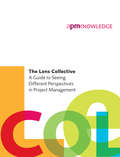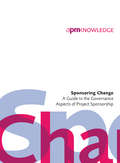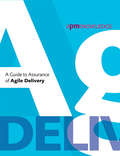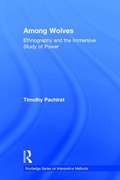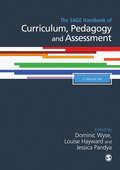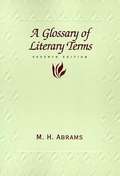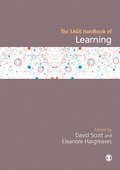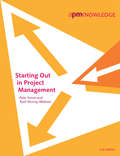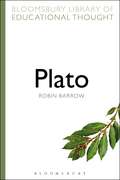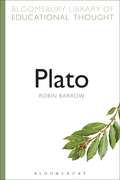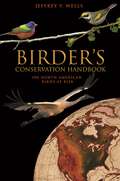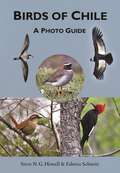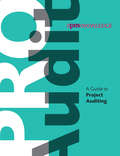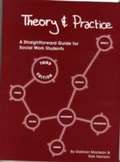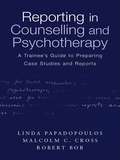- Table View
- List View
Praxis Framework
by Adrian DooleyPraxis Framework provides a single, integrated framework for the management of projects, programmes and portfolios. Written by Adrian Dooley Hon FAPM, and published by APM, Praxis takes the principles of existing, proven guides and adapts them so that they have a common terminology, structure and approach. The resulting framework, combining knowledge, processes, competence and capability maturity, makes Praxis a must read for anyone committed to advancing the cause of professional P3 practice. This book is fully aligned to the Praxis Framework certification at foundation and practitioner level.
Project Risk Analysis and Management Guide
by APM Risk Management Specific Interest GroupRisk is present in all project work, whatever the nature of the project, or the environment in which it is undertaken. The Project Risk Analysis and Management (PRAM) Guide 2nd edition, written by the APM Risk Management Specific Interest Group focuses on the risk issues that affect the project manager. It addresses how the risk management process at project level connects to corporate or programme level risk management. This guide offers the latest practices, opportunities, governance, benefits and behavioural issues. Readers of this publication may also be interested in Interfacing Risk and Earned Value Management and Prioritisng Project Risks.
Prioritising Project Risks
by Risk Prioritisation Group of the APM Risk Management Specific Interest GroupPrioritisation is an important part of any risk management process because it focuses on what matters most. Written by the Risk Prioritisation Group of the APM Risk Management Specific Interest Group, this guide looks at how the first step towards effective risk prioritisation is an understanding of its purpose. Complementing the APM Project Risk Analysis and Management (PRAM) Guide 2nd edition, it offers a variety of risk management techniques and will help practitioners and students. Readers of this publication may also be interested in Interfacing Risk and Earned Value Management and Project Risk Analysis and Management Guide 2nd edition.
The Lens Collective
by APM People Specific Interest GroupThe term ‘lens’ has been specifically chosen for this guide to reflect the analogy between human vision and the interaction of people. This context also facilitates the analogy between the tools and techniques used to enhance, correct, protect and improve this interaction. This guide, written by the APM People Specific Interest Group, is intended to help individuals reflect upon their capabilities, increase their awareness of others and successfully apply new perspectives to their projects. Readers of this publication may also be interested in APM Body of Knowledge, 6th edition.
Sponsoring Change
by APM Governance Specific Interest GroupWith the role of project or programme sponsor being still widely misunderstood and poorly practised, this eagerly awaited publication aims to improve sponsorship performance. Sponsoring Change applies to all types of organisations and sectors. Its use will improve governance, bringing greater rewards to organisations undertaking significant projects as well as to their owners and to wider stakeholders. It explains: why sponsorship is needed; the critical attributes of sponsorship; what a sponsor does. The implementation of a thorough peer review process prior to publication ensured that the guide provides a widely valued contribution to good governance and sponsorship. Readers of this publication may also be interested in Directing Change, Co-directing Change and Directing Agile Change
A Guide to Assurance of Agile Delivery
by Apm Assurance SigSuccessful agile projects are characterised by rapid, value-driven, iterative change cycles – and good project assurance, the latest guide from APM explains. A Guide to Assurance of Agile Delivery shows how undertaking traditional assurance reviews can be adapted and adopted to ensure assurance activity of agile projects is both effective and valuable. Written by the APM Assurance Specific Interest Group (SIG), the guide supports experienced assurance professionals who may be undertaking assurance of their first agile project. The authors say: “This guide has been compiled in order to support those professionals in gaining an understanding of the ‘high level’ basics of agile, the differences in approach required to undertake effective assurance activity along with pointers to specific areas to look out for when conducting assurance reviews.” Readers may also be interested in Directing Agile Change and A Guide to Integrated Assurance. Book review: This book is well structured to provide a step by step process to successfully conducting an audit review. Each chapter is clearly set out to take you through the process. The approach, environments, governance and risk checklists provided at the end are a particularly useful summary of the key questions to ask. A Guide to Assurance of Agile Delivery is useful not only for assurance professionals but also for project managers delivering agile projects. It gives succinct guidance on the key items required for good governance and successful outcomes using an agile approach. A star rating of 5 for a straightforward concise book which delivers the information required in a clear format. Christine Burt
Introduction to Managing Change (PDF)
by APM Enabling Change SIGAPM’s Introduction to Managing Change has been published and is available to order. The book discusses the importance of managing change effectively in order to successfully deliver and realise the benefits of projects, programmes and portfolios. Inside readers will find key principles and practices, as well as guidance on the appropriate application of different change management methodologies. Introduction to Managing Change is ideally suited to project professionals undertaking change programmes and projects, or those directing or sponsoring change. Writing in the foreword, Professor Tim Brady describes the guide as supplementing traditional project management tools and methods with “knowledge about how to manage the change which is an inevitable part of the process of today's complex projects”. Readers may also be interested in Directing Change, Sponsoring Change and Directing Agile Change.
APM Guide to Contracts and Procurement (PDF)
by Apm Contracts Procurement SigAPM Guide to Contracts and Procurement: For Project, Programme and Portfolio Managers offers a basic understanding of ‘how to’ procure sub-project works and to manage delivery through the phases of the procurement life cycle. The guide breaks down the process of procurement of significant packages of work into individual stages. This enables the busy project manager to swiftly understand the key points required at the outset, or mid-flight, when corrective action may be needed. Each stage includes an easy-to-follow flow diagram, including the necessary inputs and outputs. Created by a panel of authors with hands-on experience, the guide is aimed at project professionals and stakeholders within organisations e.g. financial officers, who wish to increase their awareness of how sub-projects can be procured.
Governance of Co-owned Projects (PDF)
by Hartley Millar Association for Project Management StaffGovernance of Co-Owned Projects is a direct response to the challenge of managing projects in an increasingly interconnected world. As the guide explains: ‘The challenge for organisations who sponsor or deliver co-owned projects is that traditional project management frameworks and methods are based on governance structures that assume a single hierarchical route for authority and accountability. This is rarely the case for co-owned projects, which is why organisations are rightly challenging whether their traditional governance arrangements are fit for purpose.’ Inside, readers will find the principles for the governance of co-owned projects, together with checklists and key questions for co-owners to ask. Governance of Co-Owned Projects is aimed at those who influence corporate governance in organisations including company directors, project portfolio directors and sponsors. Governance of Co-Owned Projects is the successor to the highly-regarded Co-Directing Change publication. Readers may also be interested in: Directing Change, Sponsoring Change and Directing Agile Change.
Agile project management: a panacea or placebo for project delivery?
by ApmOn 7 July 2017, the Association for Project Management (APM), the Chartered body for the project profession, held an Agile Summit with its corporate partners, government bodies and key stakeholders to start the process of shaping the APM’s position on agile project management in the wider context of professional project delivery. Stimulated by input from practitioners and interested parties from the wide range of sectors who attended the event, this report aims to lay out key themes that drew a consensus. The event sought to focus on agile project management applied other than to ‘pure’ software development, and this discussion paper deliberately avoids the use of agile taxonomy. As the event was carried out under terms of full confidentiality, the specific detail of contributions is not being disclosed. All the examples shared at the event were of cases where agile project teams were assembled from inside the organisation concerned with internal clients. We encourage all those interested in how agile might impact their work and business to use this document to help inform debate within their organisations and networks. If you would like to contribute further to evolving this area of interest, please contact knowledge@apm.org.uk.
Building Sponsors (PDF)
by ApmA guide to project sponsorship Background Project sponsorship offers organisations huge opportunities when implemented successfully. While significant work has been undertaken to improve project performance via project delivery teams, little has focused on critical issues of sponsorship and leadership. This may be attributed to the sponsor’s role being hard to define and lacking traction in the boardroom. In 2015, APM ran an extensive research project investigating the Conditions for Project Success. The 12 conditions provide a conceptual framework against which real project delivery could be assessed. The research concluded that while the conditions were widely accepted as being integral to successful project delivery, they were infrequently applied and almost never in full. In five of those conditions, the project sponsor has the lead role. Sponsors’ Summit APM has committed itself to addressing this critical enabler of project success. In January 2018, APM held a Sponsors’ Summit with it's Corporate Partners, government bodies and key stakeholders to start the process of building a shared understanding of how to improve the sponsorship of projects, programmes and portfolios. The summit focused on real-world experiences from the wide range of sectors represented, and was undertaken under terms of full confidentiality. Building sponsors – future project leadership This report lays out key themes that drew a broad consensus. We encourage all those interested in how sponsorship might impact their work and business to use this document to help inform debate within their organisations and networks.
Among Wolves: Ethnography and the Immersive Study of Power (PDF)
by Timothy PachiratSummoned by an anonymous Prosecutor, ten contemporary ethnographers gather in an aging barn to hold a trial of Alice Goffman’s controversial ethnography, On the Run. But before the trial can get underway, a one-eyed wolfdog arrives with a mysterious liquid potion capable of rendering the ethnographers invisible in their fieldsites. Presented as a play that unfolds in seven acts, the ensuing drama provides readers with both a practical guide for how to conduct immersive participant-observation research and a sophisticated theoretical engagement with the relationship between ethnography as a research method and the operation of power. By interpolating "how-to" aspects of ethnographic research with deeper questions about ethnography’s relationship to power, this book presents a compelling introduction for those new to ethnography and rich theoretical insights for more seasoned ethnographic practitioners from across the social sciences. Just as ethnography as a research method depends crucially on serendipity, surprise, and an openness to ambiguity, the book’s dramatic and dialogic format encourages novices and experts alike to approach the study of power in ways that resist linear programs and dogmatic prescriptions. The result is a playful yet provocative invitation to rekindle those foundational senses of wonder and generative uncertainty that are all too often excluded from conversations about the methodologies and methods we bring to the study of the social world.
The SAGE Handbook of Curriculum, Pedagogy and Assessment
by Ms Jessica Pandya Professor Dominic Wyse Ms Louise HaywardThe research and debates surrounding curriculum, pedagogy and assessment are ever-growing and are of constant importance around the globe. With two volumes - containing chapters from highly respected researchers, whose work has been critical to understanding and building expertise in the field – The SAGE Handbook of Curriculum, Pedagogy and Assessment focuses on examining how curriculum is treated and developed, and its impact on pedagogy and assessment worldwide. The Handbook is organised into five thematic sections, considering: · The epistemology and methodology of curriculum · Curriculum and pedagogy · Curriculum subjects · Areas of the curriculum · Assessment and the curriculum · The curriculum and educational policy The SAGE Handbook of Curriculum, Pedagogy and Assessment’s breadth and rigour will make it essential reading for researchers and postgraduate students around the world.
A Glossary Of Literary Terms
by M. H. AbramsFirst published in 1957, A Glossary of Literary Terms contains succinct essays on the terms used in discussing literature, literary history, and literary criticism. This text is an indispensable reference for students.
The SAGE Handbook of Learning
by Dr Eleanore Hargreaves Professor David Scott"Profound and useful, readers will benefit from the systematic treatment of learning through superb scholarship. Cultural-philosophical-curricular-pedagogical-historical perspectives on learning, curriculum, pedagogy, and assessment, and learners make this collection unique." - Carol A. Mullen, Professor of Educational Leadership, Virginia Tech Learning is a fundamental topic in education. Combining traditional views of learning and learning theory with sociocultural and historical perspectives, this Handbook brings together original contributions from respected researchers who are leading figures in the field. The editors provide a insightful introduction to the topic, and the theories, frameworks, themes and issues discussed in the individual chapters are central to each and every learning episode. The Handbook is organized into four sections, each beginning with a short introduction: Philosophical, Sociological and Psychological Theories of Learning Models of Learning Learning, Curriculum, Pedagogy and Assessment Learning Dispositions, Life-Long Learning and Learning Environments
The SAGE Handbook of Learning (PDF)
by Dr Eleanore Hargreaves Professor David Scott"Profound and useful, readers will benefit from the systematic treatment of learning through superb scholarship. Cultural-philosophical-curricular-pedagogical-historical perspectives on learning, curriculum, pedagogy, and assessment, and learners make this collection unique." - Carol A. Mullen, Professor of Educational Leadership, Virginia Tech Learning is a fundamental topic in education. Combining traditional views of learning and learning theory with sociocultural and historical perspectives, this Handbook brings together original contributions from respected researchers who are leading figures in the field. The editors provide a insightful introduction to the topic, and the theories, frameworks, themes and issues discussed in the individual chapters are central to each and every learning episode. The Handbook is organized into four sections, each beginning with a short introduction: Philosophical, Sociological and Psychological Theories of Learning Models of Learning Learning, Curriculum, Pedagogy and Assessment Learning Dispositions, Life-Long Learning and Learning Environments
Starting Out in Project Management 3rd edition
by Peter Simon Ruth Murray-WebsterStarting Out in Project Management is your essential guide to the basics of project management. Written for anyone new to projects or wishing to progress their career as a project professional Starting Out charts the journey of the APM project life cycle, from concept through to delivery and handover. Along the way readers will learn about the fundamental features of project management, including ownership of the business case, engaging with stakeholders and realising the all-important benefits of the project, plus much, much more. With over 50 diagrams to help illustrate, case study examples for each chapter and a full glossary of commonly-used terminology, Starting Out is the perfect companion for any aspiring project manager keen to make their mark on this exciting and rewarding profession. Readers may also be interested in APM Body of Knowledge and the APM Project Fundamentals Qualification Study Guide.
Plato (Bloomsbury Library of Educational Thought #Vol. 9)
by Robin Barrow Professor Richard BaileyPlato was the first and most formidable thinker to recognise that education is a fiercely contested concept, and to point out what great social and personal issues are at stake in education. He articulated a compelling argument for a liberal arts education as something peculiarly befitting free and autonomous beings. He understood the centrality of education for human well-being and flourishing. And he was the first to set forth a systematic theory of education.In this text, Robin Barrow concisely and convincingly establishes the continuing relevance of Plato's views to debates on such issues as nature vs. nurture (or genetic inheritance vs. social background), philosophy vs. sophistry (or the pursuit of true understanding vs. the pursuit of reputation, or perhaps simply truth vs. politics and the media). Questions concerning the fair distribution of education, moral education, value judgments and human nature are explored along with themes more specifically associated with Plato's philosophy such as the Theory of Ideas. The whole is embedded in a clearly presented account of the historical background to Plato's thought.
Plato (Continuum Library of Educational Thought (PDF))
by Robin Barrow Professor Richard BaileyPlato was the first and most formidable thinker to recognise that education is a fiercely contested concept, and to point out what great social and personal issues are at stake in education. He articulated a compelling argument for a liberal arts education as something peculiarly befitting free and autonomous beings. He understood the centrality of education for human well-being and flourishing. And he was the first to set forth a systematic theory of education.In this text, Robin Barrow concisely and convincingly establishes the continuing relevance of Plato's views to debates on such issues as nature vs. nurture (or genetic inheritance vs. social background), philosophy vs. sophistry (or the pursuit of true understanding vs. the pursuit of reputation, or perhaps simply truth vs. politics and the media). Questions concerning the fair distribution of education, moral education, value judgments and human nature are explored along with themes more specifically associated with Plato's philosophy such as the Theory of Ideas. The whole is embedded in a clearly presented account of the historical background to Plato's thought.
Birder's Conservation Handbook: 100 North American Birds at Risk
by Jeffrey V. WellsUntil now there has been no single, comprehensive resource on the status of North America's most threatened birds and what people can do to help protect them. Birder's Conservation Handbook is the only book of its kind, written specifically to help birders and researchers understand the threats while providing actions to protect birds and their habitats. Jeffrey Wells has distilled vast amounts of essential information into a single easy-to-use volume-required reading for anyone who loves birds and wants to ensure they are protected. At-a-glance species accounts cover in detail North America's one hundred most at-risk birds; each account is beautifully illustrated by today's top bird artists. The text includes status, distribution, ecology, threats, conservation actions and needs, and references. A distribution map accompanies each entry. Chapters discuss birds as indicators of environmental health, the state of North American bird populations, major conservation issues, and initiatives now underway to improve the health of North America's birds. Birder's Conservation Handbook is an indispensable resource for birdwatchers, researchers, naturalists, and conservationists. Reading it will inspire you to become an active steward of our birds and the habitats we share. A comprehensive guide to North America's one hundred most at-risk birds and how to protect them Compact and easy to use, with beautiful illustrations and data organized for convenient, at-a-glance reference Detailed species accounts, including distribution maps Practical advice on conservation Information on leading conservation agencies and resources
Birder's Conservation Handbook (PDF): 100 North American Birds at Risk
by Jeffrey V. WellsUntil now there has been no single, comprehensive resource on the status of North America's most threatened birds and what people can do to help protect them. Birder's Conservation Handbook is the only book of its kind, written specifically to help birders and researchers understand the threats while providing actions to protect birds and their habitats. Jeffrey Wells has distilled vast amounts of essential information into a single easy-to-use volume-required reading for anyone who loves birds and wants to ensure they are protected. At-a-glance species accounts cover in detail North America's one hundred most at-risk birds; each account is beautifully illustrated by today's top bird artists. The text includes status, distribution, ecology, threats, conservation actions and needs, and references. A distribution map accompanies each entry. Chapters discuss birds as indicators of environmental health, the state of North American bird populations, major conservation issues, and initiatives now underway to improve the health of North America's birds. Birder's Conservation Handbook is an indispensable resource for birdwatchers, researchers, naturalists, and conservationists. Reading it will inspire you to become an active steward of our birds and the habitats we share. A comprehensive guide to North America's one hundred most at-risk birds and how to protect them Compact and easy to use, with beautiful illustrations and data organized for convenient, at-a-glance reference Detailed species accounts, including distribution maps Practical advice on conservation Information on leading conservation agencies and resources
Birds of Chile: A Photo Guide
by Steve Howell Fabrice SchmittA cutting-edge photographic field guide to the birds of ChileThis is the first modern-style photographic field guide to the birds of Chile, an increasingly popular destination with birders and naturalists. Compact and easy to carry, pack, and use, Birds of Chile is ideal for curious naturalists and experienced birders alike, providing everything anyone needs to identify the birds they see. Clear photographs and brief, facing-page species accounts highlight what to look for and how to quickly identify species. The photos include both close-ups and birds-in-habitat images to further aid real-life identification. An introduction and maps provide an overview of Chile's geographic regions and their distinctive birdlife. Birds of Chile is also a great resource for birding in nearby countries, especially Argentina, Bolivia, and Peru.The first field-friendly photographic guide to the birds of ChileMore than 1,000 real-life photos and brief, facing-page text make bird identification easyOverview and maps describe the distinct bird regions of ChilePerfect for curious naturalists and experienced birders alikeCompact and easy to carry and packAlso a great resource for birding in Argentina, Bolivia, and Peru
A Guide to Project Auditing
by Apm Assurance SigWhat is an audit, why do we undertake project audits and how does it differ from other assurance methods? The answer to these and other related questions can be found in the latest APM publication, A Guide to Project Auditing. Written by the APM’s Assurance SIG, the guide explains the role of an audit, how it can be planned and undertaken, and the degrees of assurance that can be given. To help readers, A Guide to Project Auditing includes a number of resources (12 charts and tables) designed to help perform an audit review of a project, and identify the associated risks and control measures. The guide authors say: “This guide is principally intended for use by project auditors in developing an audit approach to the review and assurance of projects… it is also intended to be of value to anyone involved in the management and administration of projects.” Readers may also be interested in A Guide to Integrated Assurance and Directing Change – A Guide to Governance of Project Management.
Theory and Practice: A Straightforward Guide for Social Work Students (PDF)
by Siobhan Maclean Rob HarrisonThis is the third edition of this popular straightforward guide for social work students. Written by two experienced practice educators, the book is designed to address the anxieties that many social work students have about social work theory and the way it relates to practice.
Reporting In Counselling And Psychotherapy: A Trainee's Guide To Preparing Case Studies And Reports (PDF)
by Linda Papadopulos Malcolm C. Cross Robert BorTrainee therapists need to show practical competence through the production of client reports and case studies. Reporting in Counselling and Psychotherapy is a unique hands-on guide to this element of practical work. Using clinical examples to guide the reader, and a detailed analysis of case study and process report writing, it will show how to present clear, concise and properly presented reports. The book will be an invaluable tool, not only for those embarking on practical training in psychotherapy, counselling and psychology, but also for trainers in these areas and for clinicians writing clinical reports or case presentations.
